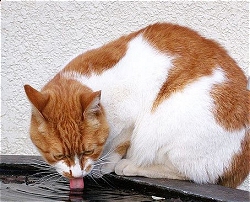Cat's drinking habits exposed
|
No-one disputes that cats are very graceful animals. Even the way they yawn or scratch is poetry in motion. But their elegant manners do not stop there - even in drinking cats have a method more elegant and efficient than other beasts. Like many predators, cats belong to a group of vertebrates with so-called ‘incomplete’ cheeks. Animals with incomplete cheeks have evolved to open their jaws wide to catch prey. The negative side of this development is that when these animals drink they are unable to fully close their mouths to create suction, as creatures such as humans do. |  Picture by Tanakawho, Tokyo, Japan |
So a different technique is needed. Dogs, for example, drink by extending their tongues into the water and folding the tongue into a cup. Then they lap the water on their tongue into their mouths. However, as anyone who has seen a dog’s water bowl can tell you, the process is not perfect, and spreads quite a bit of water around the general area of the dog.
Until recently it was assumed that cats used the canine technique of drinking but were simply a lot neater about it. However, a recent study by Dr Stocker (a biophysicist at the Massachusetts Institute of Technology in Cambridge) and colleagues showed that cats use a radically different drinking technique. If you have ever been licked by a cat, you will know that a cat’s tongue has a raspy feel to it. And that’s the cat’s secret weapon for optimal drinking.
When a cat prepares to drink, she bends the upper side of her tongue down so that the top part lightly touches the liquid. The liquid ‘holds’ onto the tongue, because its rough surface binds with the water through surface tension. As the cat quickly pulls her tongue back into her mouth, the water touching the tongue is pulled along in a liquid column. To see how this works, put the tip of your index finger flat on the surface of some water, and then pull the finger up very quickly. The water that follows your finger up is pulled by the same force as that which the cat’s tongue uses, but (naturally) cats do it better.
But there is more to it. In order for a cat to have a good drink, her jaw has to break the liquid column just before gravity does. Or as a physicist would say Felis catus exploits fluid inertia to defeat gravity.
As the cat raises her tongue, the water which adheres to the tip expands into a column. This water column is then subjected to gravitational forces which pull the water down. The laws of physics dictate that the column is at its thickest just before gravity steps in and the liquid drops back. So to keep her self-created drinking fountain running, a cat has to lap the column of water up faster than gravity can pull it down. Dr Stocker and his team showed that a cat's tongue moves as fast as one metre per second while drinking, far too fast to be observed by the naked eye, but at the optimal speed to catch most of the liquid.
So one may ask, what inspired this research in the first place? Well like many interesting discoveries, it started very prosaically. One day Dr Stocker was watching his cat, Cutta Cutta lapping up water while he was eating breakfast. After studying Cutta Cutta’s technique, Dr Stocker began to wonder if there was more to the cat’s drinking than met the eye. He filmed Cutta Cutta using a high-speed video camera which revealed the lapping motion. He and his colleagues videoed another nine cats from the local cat rescue centre to confirm that Cutta Cutta was not alone in using this technique.
But do only domestic cats drink this way? To answer that, Dr Stocker team filmed a number of big cats drinking, including a lion and a tiger at the local zoo. They confirmed that big cats use the same lapping technique, but because they are larger and have bigger tongues, they need to lap more slowly to keep inertia and gravity in balance (which indeed they do).
So the final question is - why do the cats use this unique method of drinking? Here we can only speculate. The technique is neater and more elegant - which is the feline way of doing things anyway. And as Dr Stocker points out: 'it may be related to keeping their whiskers dry, since these play a very important sensory function'.
So cats drink very tidily. Now if only they could evolve a way of using kitty litter that did not spray half of it across the room ...
Reference
Pedro M. Reis, Sunghwan Jung, Jeffrey M. Aristoff and Roman Stocker. How Cats Lap: Water Uptake by Felis catus. Science, 2010. Published Online November 11.
